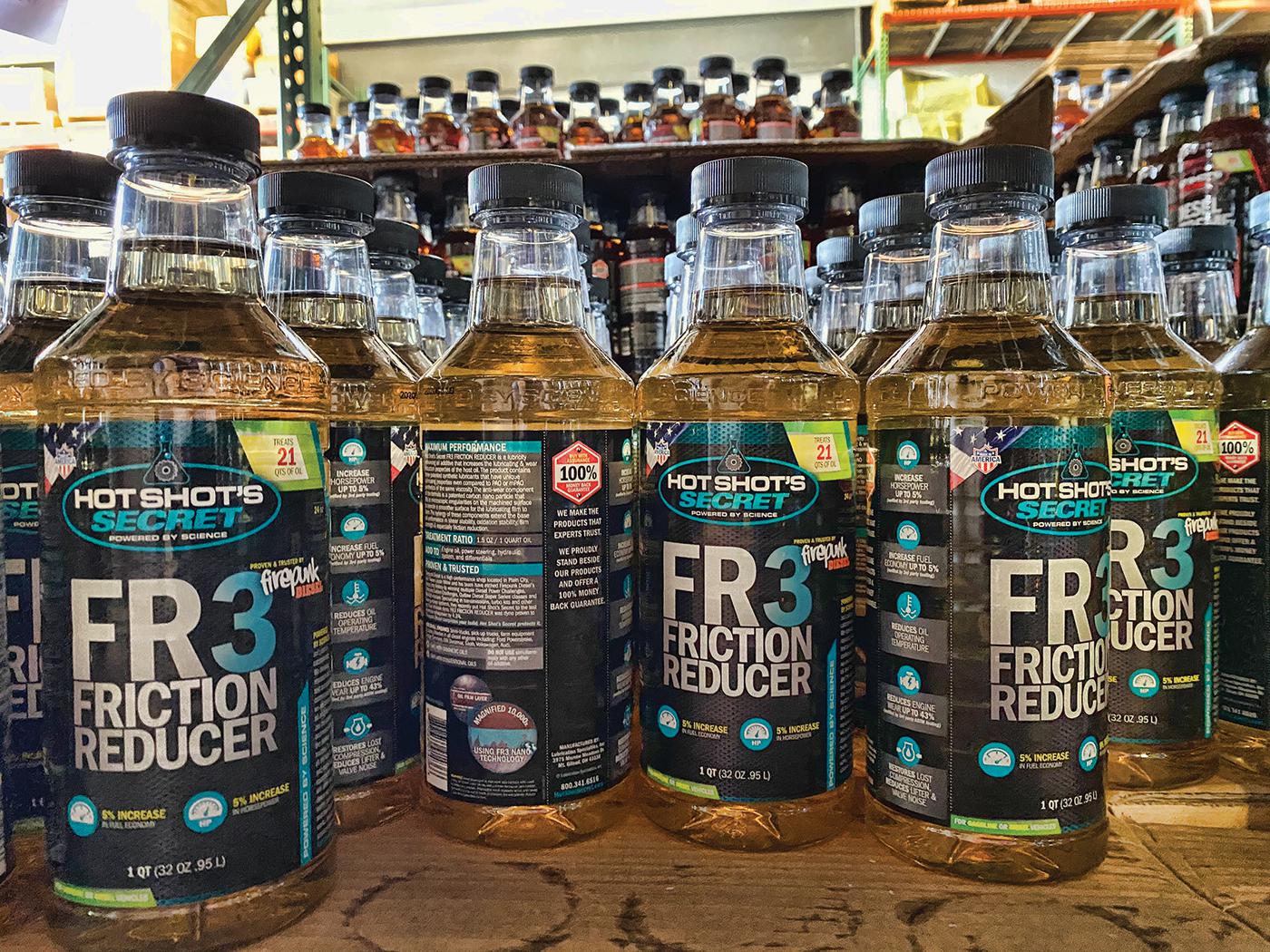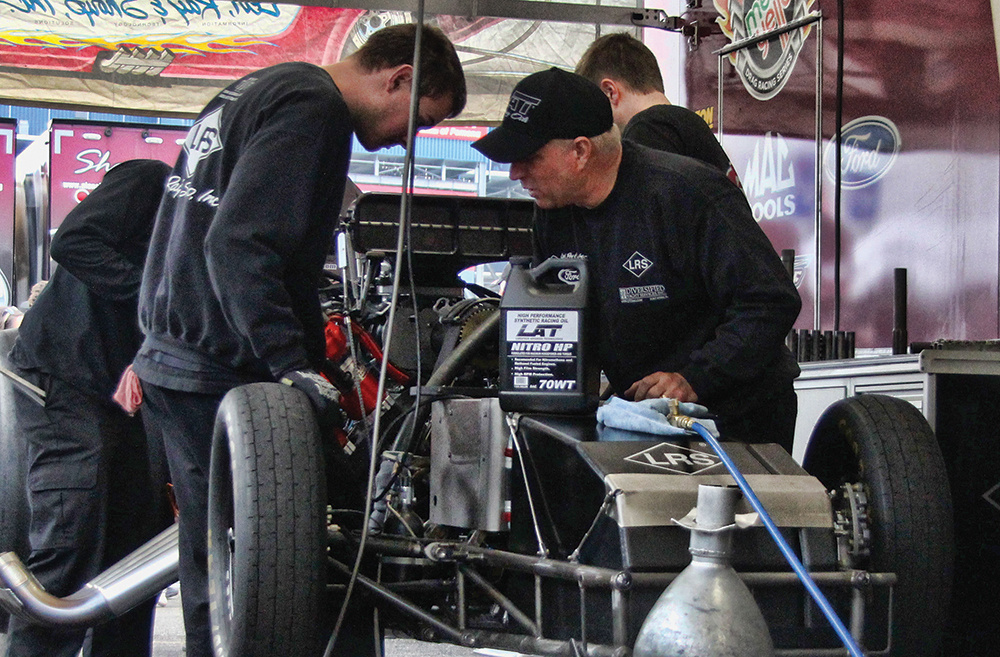Ask the Experts: Engine Oil Additives

At Hot Shot’s Secret, “Our goal is to slow the rate at which the engines eat themselves,” said a company contact, who explained that “horsepower gains are just a byproduct of an effective racing oil freeing up horsepower by reducing wear.” Pictured here is Hot Shot’s Secret’s FR3 Friction Reducer, which has been formulated using carbon nanotechnology.
Learn how to reduce friction under the hood, along with the factors that’ll help racers arrive at a solution that’s optimal for their particular application.
With unpronounceable ingredients like molybdenum, zinc dialkyldithiophosphate, and polyalphaolefin, is it any wonder that engine oil and its additives can be mysterious and confusing? To explain these and other tribological terms and shed light on how to best use them, we spoke with representatives from some of today’s top lubricant companies specializing in racing oils.
“A race engine generally operates under tight tolerances and extreme horsepower loads, and under those conditions wear takes place,” said Kyle Fischer of Hot Shot’s Secret, Mt. Gilead, Ohio. “Our goal is to slow the rate at which the engines eat themselves. We want our customers to stay on track all year and not worry about refreshing their motors multiple times a season.”
While much attention is paid to oil additives, high-quality base oil is critical for race engine protection, said Danny Vaca of LAT Racing Oils, Orange, California. Base oils are categorized into five groups. The traditional synthetic oils are Groups IV and V, the polyalphaolefins (PAOs) and esters that LAT Racing Oils uses as its base oil, he said. “The man-made synthetics have film strength, molecule-size consistency, and lubricity that are far superior and unmatched by mineral oils.”
Of the anti-wear and friction-reducing additives used in race oil, one of the most common anti-wear agents is zinc. In a race application, “we beef up the zinc package far more than in a standard passenger car oil because of all the extra anti-wear that’s needed,” Fischer said. “Probably 98% of the industry uses ZDDP,” a phosphorous-based zinc. Hot Shot’s Secret formulates its oil with a sulfur-based zinc which, Fischer admitted, is expensive but is also “a better zinc agent. We can use less zinc when it’s sulfur-based, which leaves room for more good stuff for our tribologists to add to the package.”
While a certain zinc threshold is good, too much zinc “will break down the oil,” Fischer said. One of ZDDP’s beneficial properties is as an anti-oxidant, “but too much ZDDP does the opposite and oxidizes the oil. Once oxidation starts, the oil will shear, come out of grade, and lose all its protective qualities.” For that reason, he advised racers against “making their own racing oil by really jacking up the ZDDP package. Leave the lubricant blending to the experts.”
Molybdenum, a metal better known as moly, is a popular friction reducer. LAT Racing Oils’ liquid friction reducer additive—the “LFR” on the bottle label—is “a mixture of moly, boron, and other friction modifiers,” Vaca said. The amounts are carefully controlled because, as with ZDDP, too much of a friction reducer can be harmful to power production. “Some people will over-treat an oil, thinking more is always better, but it’s not. Not carefully balancing formula components and instead adding too much friction modifier is going to negatively affect ring seal and not be able to hold compression.”
Hot Shot’s Secret formulated its FR3 Friction Reducer using carbon nanotechnology, Fischer said. The nanoparticles in FR3 are “microscopic carbon balls” that will “find a machining mark in a new engine or a wear mark in an engine with some run time on it and fill them in, making a flat film layer. That allows us to build nano lubricant on top of that film layer to protect both surfaces from touching.”

The choice of oil additives can vary by racing discipline, Vaca said. “A road race engine can use synthetic or conventional oil, which will work very well. A drag race engine requires a much higher-end oil for maximum performance, like a Group IV or V, because of the high rpm. The road race engine is also going to need more of a detergent pack to keep that oil healthy over a longer period of time than a drag car. The drag racer changes oil every three to four passes, while the road racer changes their oil every three to four races.”
To Jeff Green of Blud Lubricants in Medina, Ohio, it’s not the racing but the “fuel type that’s going to drive the product put into that engine. If someone is running an alcohol dragster and uses a conventional oil, the detergents in that oil will hold water in there and cause all kinds of issues. Whereas an alcohol oil has very few detergents in it for that reason.” Conversely, a diesel engine “needs more detergents because of the particles it’s producing during the combustion process.” And nitro? “Nitro’s tough on any oil,” Green admitted. “It needs an alcohol oil, but it has to be changed much more often. Nitro destroys the oil.”
Ultimately, all of our sources agreed that communication with your oil supplier is the best way to arrive at an oil additive package that’s right for a particular race vehicle.
“High-end racers who produce an extreme amount of horsepower need to ask questions of the oil companies about what the oil contains and get good technical support for their products,” advised Vaca. “Do the research. Ask questions. I’d love to sell you my most expensive oil, but that may not be what you need.”
“We at Blud have a very extensive support program for racers to make sure they’re getting the right oil,” said Green. “Talk to the oil company. I love hearing from racers. My favorite part is talking to the guys.”
The research should begin with an oil analysis, Fischer said. “Get a baseline. Let’s see how the oil is performing and if we can improve on that. By improvement, I’m talking about particle count. These guys love to see horsepower gains, and we show them all the time. But horsepower gains are just a byproduct of an effective racing oil freeing up horsepower by reducing wear. I want to see that particle count in an oil analysis drop. I want to see the engine eating itself less by the changes we’re making.”
SOURCES
Blud Lubricants
bludlubricants.com
Hot Shot’s Secret
hotshotsecret.com
LAT Racing Oils
latracingoils.com
 MEMBERSHIP LOGIN
MEMBERSHIP LOGIN JOIN PRI
JOIN PRI


